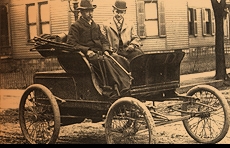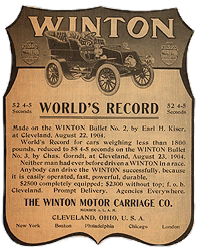ExcerptsIt's a FactIn Cleveland... After Alexander Winton produced his first horseless carriage in 1896, he was followed by many others. By 1930, 75 different nameplates had graced radiators of automobiles made in Cleveland. In 1904 the city was the nation's largest auto producer. Although Cleveland eventually lost the "Motor City" title to Detroit, Cleveland has long been the nation's second largest manufacturer of automotive components.
WantedWinton Automobile, Bicycle and diesel literature, postcards, letters, factory magazines; "The Auto Era," Ephemera, photos, miscellaneous memorabilia.
Bernie Golias |
IntroductionFor over thirty years the Winton automobile factory on Cleveland's west side has been my second home. My family has been operating a business on these premises since 1961, and I have been working there in one capacity or another since 1968. Over the years I became curious about Alexander Winton and his factory, and to satisfy that curiosity I began collecting Winton literature and talking to former Winton employees and their families. Based on what I learned I began to recognize and identify traces of the factory's previous life all around. The place had been remodeled by former tenants so many times that there were walls within walls and new floors on different levels where once there had only been one level. When we did our own remodeling to suit our metal fabricating business we would sometimes remove or replace these earlier modifications. Behind every false wall and beneath every old floor we would find vestiges of the original Winton factory. Gradually I developed a discerning eye and was able to see traces of Winton history in plain sight, sometimes covered with paint and sometimes untouched. High above me in the cross beams I could see the script letter W painted there by the original builders, and running along the rafters I could see pipes and fittings that I later learned had once been the Westinghouse electric arc light system. Marks here and there, on the brick walls, on the wood columns and beams, on the stair wells, surrendered clues to previous activities such as body building, painting and upholstering. |
I could see where the foundry had been, where the overhead belts and pulleys had been installed and the location of the original coal-fired boilers. After electric lights became commonplace early in the century most of the windows had been filled by brick or covered by wood, but I could visualize how the Winton factory had functioned with only sunlight and electric arc light for illumination. The more I looked the more I saw, and gradually the factory began to take on a life of its own in my mind's eye. In fact, occasionally, while standing at the top of the stairs leading to my second floor office and gazing down at the factory floor, I can visualize a brand new 1903 two-cylinder Winton being slowly driven down the length of the building, hearing the quiet purr of its precision-made engine, and being dazzled by the sparkle of its brass and deeply-buffed mirror-like finish. As the result of collecting Winton literature and photos for so many years and talking with members of the Winton family in connection with the 1997 reunion and reenactment of the Cleveland to New York record run of 1897, these mental images have been expanded to such an extent that I can now look at the Winton automobiles in the collection of the Crawford Auto-Aviation Museum in Cleveland and visualize them being built in "my" factory I can look at their two Bullet racing cars (on loan from the Smithsonian) and see them screaming around a track and hear them roaring down a beach, Barney Olcifield straining to maintain control of them. This book is intended to impart to the reader the same sense of history and wonder surrounding the Winton factory and the Winton legacy that I have found so fascinating. Bernard Golias; December, 1996 |

